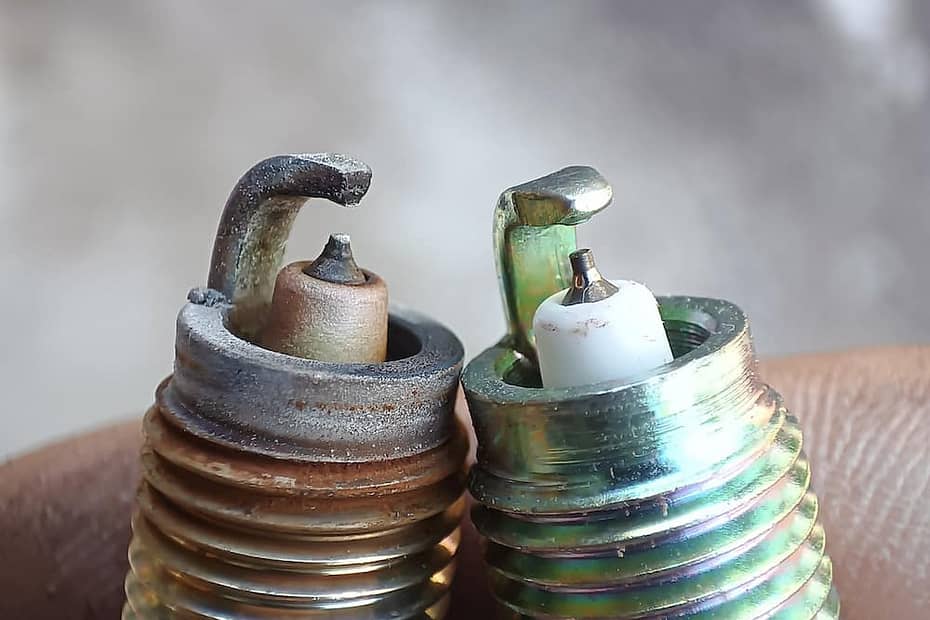To tell if a spark plug is bad, check for signs such as engine misfiring or difficulty starting the car. A bad spark plug can cause performance issues and affect fuel efficiency, making it important to address the problem promptly.
When your vehicle experiences these symptoms, consider inspecting and replacing the spark plugs as necessary. Taking care of your spark plugs is crucial for maintaining the health and performance of your engine. This article explores the signs of a bad spark plug, helping you diagnose and resolve the issue to keep your vehicle running smoothly.
Whether you are a DIY enthusiast or rely on a mechanic, identifying a faulty spark plug can save you time and money in the long run.
Signs Of A Bad Spark Plug
A bad spark plug can cause rough idling, engine misfires, and decreased fuel efficiency. You may also notice difficulty starting the engine and a decrease in overall vehicle performance. Visual signs of a bad spark plug include oil deposits, worn electrodes, and a gap that’s too wide.
Regular inspection and maintenance can help prevent these issues.
Engine Misfires
If your engine is misfiring, it could be a sign of a bad spark plug. Engine misfires occur when the spark plug fails to ignite the air and fuel mixture in a cylinder at the right time. This leads to a lack of power and a noticeable sputtering or jerking sensation. Misfires can occur sporadically or consistently, and they can be more noticeable when accelerating or under load.
Rough Idle
A rough idle is another common sign of a bad spark plug. When a spark plug is malfunctioning, it can result in an uneven combustion process, causing the engine to feel rough and shaky at idle. You may notice your car vibrating or shaking more than usual when stopped at a red light or in park. A rough idle can also be accompanied by a fluctuating RPM (revolutions per minute) on the tachometer.
Difficulty Starting
If you’re having trouble starting your car, it could be due to a faulty spark plug. Spark plugs are responsible for igniting the air and fuel mixture in the cylinders, allowing the engine to start. When a spark plug is worn out or fouled, it may not produce a strong enough spark to initiate the combustion process. As a result, you may experience prolonged cranking or multiple attempts before the engine finally starts.

Credit: blog.mccarthymorsechevrolet.com
Symptoms Of A Bad Spark Plug
A bad spark plug can cause various issues in your vehicle’s performance. By being aware of the symptoms, you can identify and resolve spark plug problems before they worsen. Here are three common symptoms of a bad spark plug:
Poor Fuel Economy
A bad spark plug can negatively impact your vehicle’s fuel economy. When a spark plug isn’t functioning correctly, it can misfire or produce a weak spark, leading to incomplete combustion of the fuel-air mixture. As a result, your engine may consume more fuel than necessary to compensate for the lack of power. This inefficient combustion process can significantly decrease your overall fuel economy.
Lack Of Acceleration
A noticeable decrease in acceleration can be a clear indicator of a bad spark plug. In a healthy engine, each spark plug produces a spark that ignites the fuel-air mixture, creating an explosion that generates power. However, a faulty spark plug may not ignite the mixture effectively, resulting in weaker combustion and reduced engine power. This lack of power can manifest as sluggish acceleration, making it difficult to reach higher speeds or pass vehicles efficiently.
Engine Surges
An engine surge is when your vehicle’s engine speeds up and down unexpectedly, even when you’re driving at a consistent speed. This erratic behavior can be caused by a bad spark plug. When a spark plug is failing, it can intermittently misfire, causing the engine to receive inconsistent power. These fluctuations in power can lead to engine surges, disrupting the smooth operation of your vehicle.
Causes Of Bad Spark Plugs
Bad spark plugs can cause a range of issues with your vehicle, affecting its performance and fuel efficiency. Identifying the causes of bad spark plugs is essential for maintaining the optimal functioning of your car. Here, we discuss the primary reasons behind bad spark plugs, including normal wear and tear, carbon build-up, and improper gap.
Normal Wear And Tear
Due to the continuous, high-voltage electrical power they receive, spark plugs inevitably undergo normal wear and tear over time. This wear results from the erosion of the electrodes and insulator, as well as the build-up of carbon deposits. In turn, this affects the functionality of the spark plug, leading to potential misfires, rough engine idling, and reduced fuel economy.
Carbon Build-up
Another common cause of bad spark plugs is carbon build-up, which occurs when carbon deposits accumulate around the electrode and insulator, impeding the spark’s ability to form. This can lead to a weak or inconsistent spark, impacting engine performance and fuel consumption. Additionally, excessive carbon build-up can cause spark plug fouling, resulting in engine misfires and decreased power output.
Improper Gap
The gap between the center and ground electrodes of a spark plug is critical for efficient combustion within the engine. An improper gap, either too wide or too narrow, can hinder the spark plug’s ability to produce a strong spark, leading to various issues such as engine hesitation, power loss, and increased emissions. It is essential to regularly check and adjust the gap according to the manufacturer’s specifications to ensure optimal spark plug performance.

Credit: wilcomotosave.co.uk
Diagnosing Bad Spark Plugs
Spotting bad spark plugs is crucial for maintaining a smooth-running engine. Look out for symptoms like misfires, poor fuel economy, and difficulty starting your vehicle, as they may indicate a need to replace your spark plugs. Regular inspection and timely replacement can keep your engine running at its best.
Diagnosing Bad Spark PlugsVisual Inspection
Inspect spark plugs for wear and deposits, such as fouling or corrosion.
- Check for worn electrodes and cracked insulators.
- Look for black soot, which indicates a rich fuel mixture.
Using A Spark Plug Tester
Use a spark plug tester to check for proper spark plug functionality.
- Connect the tester to each spark plug wire.
- Observe the intensity and color of the spark generated.
Preventing Bad Spark Plugs
Spark plugs play a crucial role in your vehicle’s performance. Identifying bad spark plugs early on can prevent issues like engine misfires and reduced fuel efficiency, ensuring smooth and efficient operation. Look out for signs such as rough idling, difficulty starting, and decreased acceleration to determine if your spark plugs need attention.
Regular Maintenance
Regular maintenance is crucial in ensuring the longevity of your spark plugs. Performing scheduled tune-ups and check-ups can help catch any issues before they worsen.
Using Quality Fuel
Quality fuel is a key factor in maintaining the health of your spark plugs. Choosing premium or high-grade fuel can reduce build-up and prolong the life of your spark plugs.
Proper Engine Warm-up
Proper engine warm-up is essential to prevent stress on your spark plugs. Allow your engine to warm up gradually before driving to protect your spark plugs.

Credit: vatire.com
Frequently Asked Questions On How To Tell Bad Spark Plug
What Are The Symptoms Of A Bad Spark Plug?
Symptoms of a bad spark plug include rough idling, engine misfires, reduced fuel efficiency, and difficulty starting the engine. Additionally, you may experience a lack of acceleration or a noticeable drop in power while driving. Regular inspection and maintenance can help prevent these issues.
How Do I Know If Spark Plugs Need Replacing?
You’ll notice rough idling, poor acceleration, and difficulty starting your car when spark plugs need replacing.
How Do You Check If A Spark Plug Is Good?
To check if a spark plug is good, remove it and inspect for wear, deposits, and cracks. Test for spark quality using a spark tester tool.
Can A Bad Spark Plug Still Spark?
Yes, a bad spark plug can still produce a spark. However, it may not be strong enough for optimal performance and can cause issues. Regular maintenance is important to ensure proper spark plug function.
Conclusion
Identifying bad spark plugs is essential for maintaining optimal engine performance. By paying attention to warning signs such as misfiring, decreased fuel efficiency, and difficulty starting your car, you can address spark plug issues early. Regular inspection and replacement can help prevent serious engine problems, ensuring a smoother and more reliable driving experience.
